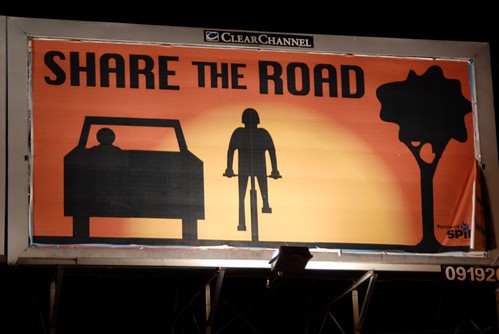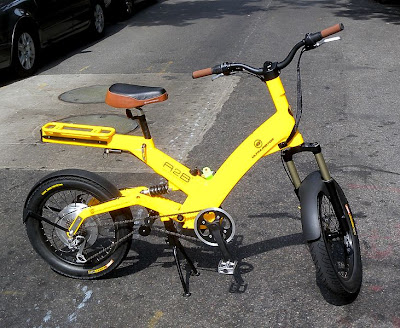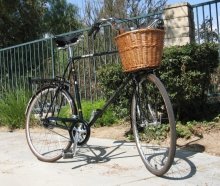I asked for an interview, and he agreed. His answers were modest, insightful and straightforward. Enjoy.
 Walt, working
Walt, workingPhoto by Ed Ellinger
A: Well, the story goes something like this: I was employed as a technical editor for the DOE at Los Alamos National Lab, but funding for the renewable energy programs started drying up, so I was offered the choice of a job I didn't like... or a layoff. So I was looking for something to do (this was 2003) and my good friend Feldman forwarded an ad for an Anvil framebuilding fixture he'd found online. So, on a whim, I bought it, along with some very basic welding and metalworking equipment, and started building bikes for all my friends (and myself, of course). My first frame was built for my wife for her birthday, weighs 7 pounds, and looks like it was built by a 6 year old. And it took me a month. But I improved, thank god, with practice, and eventually people I didn't know wanted to pay me for frames. So I bought some liability insurance (this is 2004 now), put up a website, and things basically snowballed from there.
To be honest, I do not have a real concrete vision for the future of the company. I will keep doing it as long as people want bikes and I am having fun with it. It's not tremendously profitable, but it's enough to pay bills, put food on the table, and even go on vacation now and then, so that's good enough for me. At some point I'd like to offer more of an "experience" for the customer - meaning work out of a much larger shop in a location where someone could come and go for a riding vacation and watch their frame built and assembled (and get to test ride it and have me make changes if needed). I do enjoy talking to people about what I do and showing them how frames come together, and that's something that customers also tend to really enjoy, so it would be really cool to offer a more experiential service. That's in the distant future, though, as my current space is much too cramped for multiple people. I would not mind hiring an employee or two down the road (packing boxes and making parts orders gets pretty old after a while), but once again, that would have to be at another location.
Q: According to your website, you enjoy building custom forks. I know a lot of folks experimenting with fork geometries for Porteur-style bicycles. Can/will you build forks to just about any spec, or do you prefer to build them in the geometries you like?
A: I'll happily build any fork geometry a customer wants. I've done everything from 20" to 36" wheel forks with configurations all over the map. I'd estimate I've built 400 forks at this point, so I've seen a lot of different stuff and am pretty adaptable with unusual requests.
Q: What else do you love to build? Where do your passions lie?
A: I like building almost anything that's metal. I've built berry-picking devices, furniture, terrarium equipment, home carbonation systems, and even a crutch for my neighbor. I also really enjoy fixing stuff (not just bikes) and solving fun little problems. Of course I like riding bikes of all kinds, as well as rock climbing, yoga, and cooking.
Q: I love 36"-wheel bicycles! And, at 6'6", it seems like I could use 36" wheels to build a bicycle with a nearly normal geometry. Given the wheel parts available, can a 36"-wheel bicycle be a real, practical alternative? Or are they just fun toys for people who want to be seen? What else would you like to say about 36"-wheel bicycles?
A: As of now, 36ers are at the novelty stage. What I mean by that is that the components (primarily rims and tires) are pretty substandard (the tires are 4-ply slicks that weigh in excess of 2000 grams, the rims are pretty similarly junky). That being said, they are very enjoyable to ride even with all that extra wheel weight, and the next few years will probably tell if the size "takes off" to the point where there's at least one decent tire and rim (something equivalent to the launch of the 29" Nanoraptor in 1999). I've explored having a run of tires and rims made, but as of now, there are fewer than 50 bikes on earth that would use them, so it's hard to justify the cost and risk (and yes, I'm aware that there are lots of unicyclists who ride this size).
 Little Lady, Big Wheels
Little Lady, Big Wheels(At least she looks little compared to those 36" monsters)
Photo by Brad Bedell
Sizing is interesting. A 36er can be built to work pretty well for someone down to about 5'10" tall, but to really do something without any serious geometry tradeoffs, you're looking at the very tall folks - probably 6'4" and bigger at a minimum. If you're looking to win races or beat your buddies to the top of a climb (or the bottom, really), a 36er probably isn't for you. If you enjoy having a different experience on the bike and want to get lots of attention while doing it, they're great. So yes, they are "fun toys for people who like to be seen", but they also have a lot of enjoyable attributes that make them a worthwhile addition to a bike collection for the right rider (you think your 29er rolls over stuff well? You ain't seen *nothing* yet!)
It's also worth pondering whether it would be better (since the existing 36"-specific parts are crap) to scrap the size in favor of something else. There's an argument to be made for something between 29 and 36 (32"?), and making it happen wouldn't be any harder, really, than getting good stuff for the 36" size.
Q: What off-the-shelf bicycles do you recommend for people who cannot afford custom?
A: I used to like Cannondale, since they made their higher-end stuff in the US, but that's over with now.
That said, $2500 is still a lot of money to many people, and if someone's looking for a bike in the $1000 range, I don't spend much time shopping around for them, but I remember Giant and Surly being a good deal. Ventana, Ellsworth, and a few others still make bikes in the USA for folks who care about that (like me), but they tend to be just as pricey (or more) than custom.
Q: What components do you recommend for different types of bicycles? Is there anything new out there that has impressed you recently?
A: I don't have strong component preferences - ride whatever is comfortable and works. I do like the stuff made by Paul, Phil, King, and Fox particularly since they're fine products made here in the US.
Q: Are there any bicycle fads currently underway that you absolutely despise?
A: Nope. I know I'm supposed to say hipsters and fixies (Editor's Note: I promise, I was not fishing for that response!), but I just don't really hate anyone who rides a bike for fun (or for work). There's a lot of complaining about new headset and bottom bracket standards, but I think most of them are pretty good for at least some applications. Bikes have gotten tremendously more fun and functional in the last decade or so, so I gave up being a retro grouch long ago.
I do generally dislike a lot of the stuff that I see displayed at bike shows, simply because it's pretty clear that a lot of it was never intended to be ridden, but I wouldn't say I despise that kind of thing. Bling can be fun and if your goal is to make bike jewelry, that's great. I tend to crash my bikes, though, and get them dirty, so show bikes don't usually appeal to me.
Q: We hear a lot about the bicycle culture in places like Portland, San Fransisco, and Minneapolis, but Boulder has had a strong cycling culture for decades! Tell us a bit about bicycle culture in Boulder and how it is different from places like Portland.
A: I guess I'm not sure what that question really means. People in Boulder like to ride bikes a lot, and we've got the usual groups of triathletes, roadies, mountain bikers, college kids on fixies, etc, etc. But I don't know that it counts as a "culture". I do know that there's a lot of animosity between cyclists and non-cyclists here, both on the road and the trails, and that's unfortunate, but probably inevitable given the population density of the Front Range.
Q: What else would you like to say?
A: I hope this interview wasn't too boring.
Q: What did you have for breakfast?
A: Some homemade biscuits with eggs and cheese, plus a few slices of tomato.



































